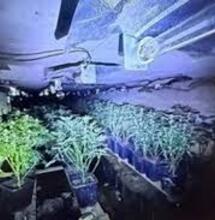Spring Planting with Grubbycup

It may still be a bit chilly, but spring will soon be here.For indoor gardens the change in seasons isn't all that dramatic. Spring, summer, fall, winter are just different settings on the lighting and temperature controls.For outdoor gardens however, there is a pre-spring moment, when the ground has been cleared and the only seeds in the garden are ones of hope and anticipation that is very special. Outdoor gardens are a cheap and natural way to grow smoke.
It may still be a bit chilly, but spring will soon be here.
For indoor gardens the change in seasons isn't all that dramatic. Spring, summer, fall, winter are just different settings on the lighting and temperature controls.
For outdoor gardens however, there is a pre-spring moment, when the ground has been cleared and the only seeds in the garden are ones of hope and anticipation that is very special. Outdoor gardens are a cheap and natural way to grow smoke.
| This 11 day old sprout will soon be ready to start the hardening process. |
| At 13 days, the sprouted seed (left) shows more progress than the sprouted 13 day old clone (right). Clones should be given an additional week to develop. |
It may still be a bit chilly, but spring will soon be here.
For indoor gardens the change in seasons isn't all that dramatic. Spring, summer, fall, winter are just different settings on the lighting and temperature controls.
For outdoor gardens however, there is a pre-spring moment, when the ground has been cleared and the only seeds in the garden are ones of hope and anticipation that is very special. Outdoor gardens are a cheap and natural way to grow smoke. However, it can also attract drama like a magnet if discovered by some idiot, so even legal weed should be grown with discretion. The biggest threat to outdoor cannabis walks on two legs.
Marijuana grows well in containers or directly in the ground. It is a very simple spice to grow (to be correct, it's a spice not an herb since the flower clusters are the part of the plant that is harvested). In my opinion, it is easier to grow a nice crop of marijuana than a nice crop of tomatoes or peppers. If you've had a successful vegetable or flower garden, you already have most of the needed skills.
Depending on the "gardening zone" of your area, spring may be just right around the corner. In most of the US cannabis is planted outdoors in April through May in anticipation of a fall harvest. Check with your local garden zone guide, but as a general rule, plant no earlier than a week after the last frost date. Plant near the spring equinox and harvest around the fall equinox.
You can put them outside later in the season, even up to midsummer, but the more time the plants spend growing, the larger they can grow, and the larger the harvest should be.
Once you know when you want to move the plants outside, count back the weeks to figure out when to start them. Outdoor plants can be started indoors by cloning or seed.
| Although not able to stand up to examination, this tomato companion affords some cover. |
Start clones indoor by taking cuttings from a known female at least three weeks in advance to have them ready to move outside. Take cuttings that include a growing tip, and at least below the next node. Dip in cutting hormone if desired, and bury the node into the growing media with the tip above the surface. Keep the media moist, but not soggy. Roots should be form in two to three weeks.
Start seeds indoors at least two weeks in advance to have them ready to move outside. When starting by seed, start at least twice the number of seeds as plants desired for harvest, as a little under half tend to be male. To avoid investing too much time and energy into male plants, once established, clones taken from the outdoor plant can be sexed indoors to learn gender. An alternative is to start with feminized seeds, which will all be female. Sprouts should be kept moist, but not too wet.
| Growing vegetables alongside marijuana can provide nutritious treats. |
One drawback to starting indoors is that the plants need to be "hardened" before they can be left outside permanently. To harden a plant, it is placed outside in a mild location for a longer period each day for anywhere from a few days to about a week. It will ease the transition from the protected indoor environment to the harsher outdoors. Plastic domes can help protect young plants. Depending on conditions, plants not hardened may die if the change in environment is too great.
If starting from seed outside, you can wait until your planting date to start. The same gender concerns as starting seeds indoors apply.
Companion planting is a method often used to help prevent outdoor plants from being attracting certain types of pests. Nearby indeterminate tomato plants bring natural defenses against some types of insects. A brief glance at green foliage with tomatoes on it can appear to be a tomato plant, and the marijuana can help provide some support for the tomato plant. Besides, homegrown produce is a worthwhile harvest of its own.
Tying open branches allows a more even distribution of sunlight, and training tall plants to bend over with twine can limit height concerns.
Fertilize with more nitrogen before the summer solstice, and gradually reduce the amount afterwards. Do the opposite with phosphorous and potassium, start with a small amount, and gradually increase use after the summer solstice.
Marijuana is a very tolerant plant, which can do well under a wide variety of conditions, both indoors and out. An outdoor temperate grow can be spectacular, productive, and save kilowatts of electricity over an indoor grow.
If you are blessed with a circumstance that will allow outdoor gardening, be thankful. It is a wonderful way to grow, as long as you can do it in peace.
Peace, love and puka shells,
Grubbycup



